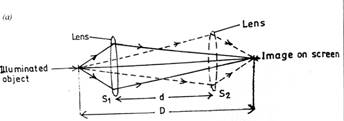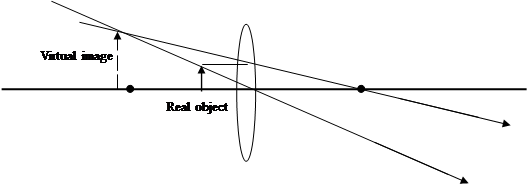Alternative A
Question 2A

You are provided with an illuminated object, a lens, a screen, a lens holder and a metre rule.
Use the diagram above as a guide to perform the experiment.
- Determine the approximate focal length f, of the lens by focusing a distant object on the screen.
- Place the illuminated object and the screen a distance D = 100 cm apart.
- Place the lens at a position S1 to obtain a sharp image of the object on the screen. Note S1.
- Move the lens to a position S2 to obtain a sharp image of the object on the screen. Note S2.
- Measure the distance, d, between S1 and S2.
- Evaluate D-1, D2, d2 and
 .
. - Repeat the procedure for four other values of D = 90 cm, 85 cm, 80 cm, and 70 cm.
In each case, evaluate D-1, D2, d2 and ![]() .
.
- Tabulate the results.
- Plot a graph with
 on the vertical axis and D-1 on the horizontal axis.
on the vertical axis and D-1 on the horizontal axis. - Determine the slope, s, of the graph.
- Given that s = 4k, determine k.
- State two precautions taken to ensure accurate results.
(b) (i) Draw and label the ray diagram of a simple microscope.
(ii) State two differences between a real image and a virtual image.
Observation
Part (a) This question was fairly attempted. Many candidates did not attempt it and few that attempted it performed fairly.
Part (b) Candidates performance was fair.
The expected response:
- (a) OBSERVATIONS
- Value of f correctly measured and recorded to at least 1 d.p in cm
- Five values of D correctly measured and recorded to at least 1 d.p
in cm.
- Five values of d correctly measured and recorded to at least 1 d.p in cm and in trend
Trend: As D decreases, d decreases
(iv) Five values of D – 1 correctly evaluated to at least 3 d.p
(v) Five values of D 2 correctly evaluated. (vi) Five values of d2 correctly evaluated.
(vii) Five values of ![]() correctly evaluated to at least 3 d.p
correctly evaluated to at least 3 d.p
(viii) Composite table showing at least D, D 2, D - 1, d, d 2 and ![]()
GRAPH
(i) Both Axes correctly distinguished
(ii) Reasonable Scales
(iii) Five points correctly plotted
(iv) Line of best fit
SLOPE
(i) Large right-angled triangle (ii) ∆![]() correctly determined
correctly determined
- ∆ D -1 correctly determined
(iv) ![]() correctly evaluated
correctly evaluated
DETERMINATION of k
k = ![]()
ACCURACY
Based on k = f ± 10% of teacher’s value
PRECAUTIONS
- Lens was placed vertically/ erect(in its holder).
- Avoided Parallax error on metre rule.
- Avoided/noted/corrected zero error on metre rule.
- Cleaned surfaces of lens.
- Repeated readings shown on table.
(b) (i)


(ii) Differences between real and virtual images
REAL IMAGE |
VIRTUAL IMAGE |
It can be focused/formed on a screen. |
It cannot be focused/formed on a screen. |
It is inverted/turned upside down. |
It is erect/upright. |
Formed by the actual intersection of light rays. |
Formed by the apparent intersection of light rays. |
